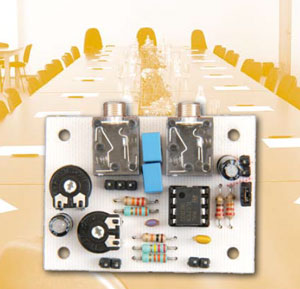Microphone Conferencing System
For more effective online meetings

For meetings that do not involve too many people the microphone built into the webcam or laptop is usually sufficient for conferencing, but for larger groups or in acoustically less than ideal rooms (with a lot of reverberation, for example) the degree of intelligibility at the other end of the line is often very low. To solve this problem we designed a simple circuit.
This is a MEMBER ONLY article. You need a subscription to read this article.
- Unlimited access to online Member Only articles
- 3 new editions Elektor Magazine (digital)
- More than 5000 Gerber files
- 20% member discount on e-books (at elektor.com)
- 10% member discount on Products (at elektor.com)
Available from €5.33 per month.
What is Members Only
Elektor is committed to providing high-quality content on electronics, catering to tens of thousands of paying members. As part of this commitment, Elektor has launched Premium, an initiative that offers exclusive online articles to members sometimes even before they appear in the magazine.
Every day, members can access in-depth articles that showcase the best of Elektor's premium content.
This initiative aims to reward members with early access. Once logged in, members can easily enjoy this exclusive content and engage in discussions about featured projects. While Premium adds to the existing resources available, Elektor will continue to provide a wealth of free information.
Join the Elektor community today to take advantage of Premium and other benefits!
Materials
Gerber file
CAM/CAD data for the PCB referred to in this article is available as a Gerber file. Elektor GREEN and GOLD members can exclusively download these files for free as part of their membership. Gerber files allow a PCB to be produced on an appropriate device available locally, or through an online PCB manufacturing service.
Elektor recommends the Elektor PCB Service service from its business partner Eurocircuits or AISLER as the best services for its own prototypes and volume production.
The use of our Gerber files is provided under a modified Creative Commons license. Creative Commons offers authors, scientists, educators and other creatives the freedom to handle their copyright in a more free way without losing their ownership.
Extra info / Update
- Simple to operate
- Two units are easily connected
- Pickup pattern of the microphones is easily adapted to suit the situation
- Easy to build using standard components
Component list
R1 = 10kOhm
R2 = 22kOhm
R3,R4 = 33kOhm
R5 = 220kOhm
R6 = 330kOhm
R7 = 220Ohm
P1 = 22kOhm trimpot, horizontal
P2 = 250kOhm trimpot, horizontal
P3 = 2.2kOhm logarithmic potentiometer
Capacitors
C1 = 10µF
C2 = 100nF
C3 = 22µF
C4 = 100pF
C5,C6 = 1µF
Semiconductors
IC1 = TL071
Miscellaneous
K1,K2 = 3.5mm jack socket, PCB mount
K3–K6 = 2-pin pinheader
K7 = 3-pin pinheader
Mating headers for K3–K7
S1 = pushbutton, 1 make contact
S2 = on/off switch
Electret microphone capsule, e.g Panasonic MCE-2020U or WM-61A
PCB # 100465-1



Discussion (0 comments)